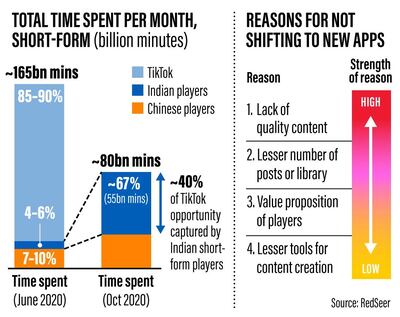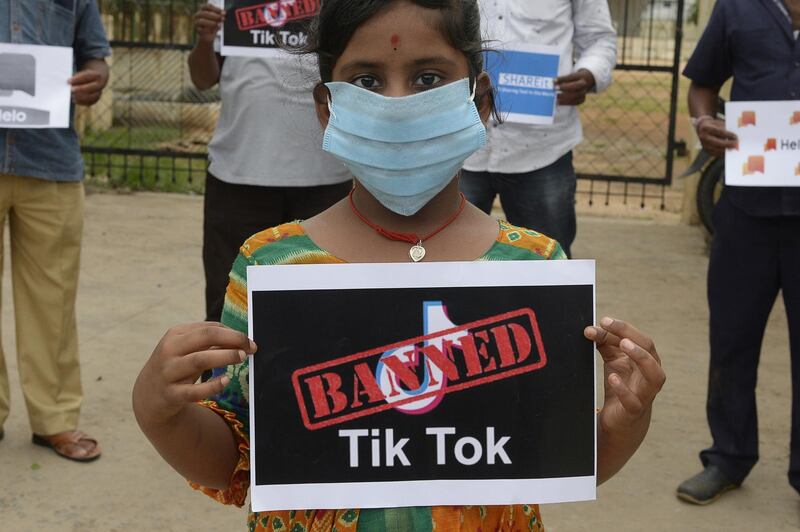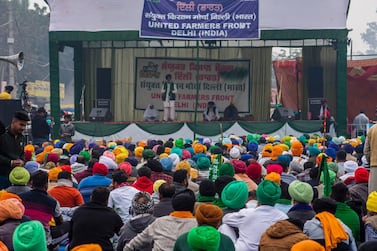April was perhaps the toughest time in modern Indian history when the nation of 1.3 billion people was in the midst of one of the world's strictest lockdowns. That is when co-founders of short video app Mitron decided to launch their venture.
While Asia's third-largest economy came to a grinding halt as businesses shuttered across the the country, it was an opportune time for an app like Mitron, which gave millions of people a chance to get some semblance of normality as users created and shared videos.
It is a fast growing, but fiercely competitive market in India and more fortune came Mitron's way in June when its biggest competition was suddenly eliminated.
The market leader in the short video space, TikTok, was banned by the Indian government along with a host of other Chinese apps amid a flare up in a border row between the two countries.
Since its launch, Mitron has had some 40 million downloads.
“Since the pandemic, we have seen a lot of people sharing a lot of video content,” says Shivank Agarwal, the co-founder of Mitron. “With the TikTok ban we got a sudden surge [as well]”.
But even before the pandemic-driven surge in the popularity of video sharing apps, broader industry trends were already indicating growth of such platforms in India.

Two of the biggest indicators are: the rise in the ownership of smartphones and internet use in India, boosted by the availability of cheaper handsets and a drop in data prices due to intense competition between telecommunications companies.
The number of internet users in India is projected to increase to 970 million from 600 million over the next five years, according to a RedSeer Consulting report this month.
Boosted by the number of users, it expects the short video market to surge four times over the same period in terms of total time spent on these platforms, reaching 400 billion to 450 billion minutes a month from 110 billion minutes currently.
Appetite for entertainment in the country is rapidly expanding “with the rise in the young millennial population and digital penetration”, says Anil Kumar, the founder and chief executive of RedSeer.
“The rise in the content apps in the last three to four years, with a lot of them focused on localised content, is proof of the strong need for entertainment in the market”.
He says that short-form video content “has emerged as a breakout category, offering light and instant fun entertainment, and saw good growth until the ban on Chinese apps”.
While the ban on TikTok has removed a major source of competition for rival Indian apps, so far only 40 per cent of the Chinese platform's market has been captured by Indian rivals, according to RedSeer's research.
A survey by the consultancy reveals that some of TikTok's users have been unwilling to move to other platforms, citing factors including a lack of quality content and fewer posts.
The popularity of the Chinese app in India was simply enormous. Last year, TikTok was India's most downloaded app, with 323 million downloads, according to RedSeer. Of TikTok's 1.5 billion downloads globally, until last year, almost one third were from India.
TikTok had a 90 per cent share of the market in India before it was banned. Users in the country spent 165 billion minutes a month on short video apps in June, which dropped to 80 billion minutes in October once TikTok was out of the picture. Indian companies made up 67 per cent of the market in October, while global firms including Facebook and YouTube accounted for the remainder of the sector.
The biggest homegrown TikTok rival apps in India are Dailyhunt’s Josh, MX Takatak, owned by Times Internet, and InMobi’s Roposo.
A short video app launched last year, Bolo Indya, says the impact of the TikTok ban on its growth was "incredible".
"We were growing at [about] 20 to 25 per cent month-on-month before the TikTok ban, and 200 per cent immediately after it and 150 per cent [every month] currently," says Varun Saxena, the co-founder and chief executive of Bolo Indya.
The challenge is that none of the homegrown apps have managed to emerge as the new TikTok yet in India in terms of scale and clout.
“A space like this demands a clear winner, and so far, a clear winner hasn’t emerged,” says Utkarsh Sinha, the managing director of Mumbai-based Bexley Advisors, an investment advisory firm focused on the tech and media sectors.
“While a number of Indian competitors have been funded [by major investors] ... no one app has become the preferred TikTok alternative”, he adds.
“It is difficult to compete with TikTok’s scale: both in terms of their user base and the 50,000 or so engineers who are solely devoted to engineering vitality and addiction [to the app]”.
But with Indian apps gaining more traction sinceTikTok's ban, investment has been flowing into the sector, which will help boost their market position.
Last week, Bengaluru-based VerSe Innovation, which owns Josh, raised more than $100 million from investors including Microsoft and Google. Post funding, VerSe Innovation says it is valued at more than $1 billion.
“VerSe plans to deploy its new capital steadily in the continued scaling up of Josh [and] the augmentation of local language content offerings,” the company said in a statement announcing funding.
Josh currently has 77 million monthly active users.
In September, ShareChat, an Indian content sharing platform, raised $40m from investors including US firm Lightspeed Venture and Twitter, with plans to push the growth of its new short video app, called Moj.
Despite the size and growth potential of the market, Mr Agarwal at Mitron says it is a highly challenging market. Obstacles include poor internet connectivity outside of India's major cities.
“We also have so many languages in India, so what is relevant in one state might not be relevant in another state,” he says.
There is a particularly huge risk looming, though, for newer apps like Mitron.
“Each of these apps also carries the risk that TikTok gets re-released in India,” says Mr Sinha. This “would unseat the competitors that have emerged since the ban”, he says.
Fundamental to the business model of these apps is getting major brands on board to drive advertising revenues, however, it will take time, according to analysts.
“The key would to be motivate influencers and that is going to happen only when there is a significant user base,” says Ashwin Sivakumar, the chief of digital business strategy, JugularSocial Group.
“It will take some time before brands look into the new bunch of video sharing apps as an integral part of their marketing mix.”
While there are a number of alternatives, adapting to the loss of TikTok has not been easy for everyone.
For TikTok influencers who generated income from brand sponsorship linked to their video posts, the ban of the Chinese app has left a huge void.
“For people like me, who treated TikTok as a serious profession, the ban came as an utter shock,” says Delhi-based Kuwarjeet Singh Rathore, also known as BabaKSR, who had built up 1.1 million followers.
He posted short videos on topics ranging from poetry to relationship advice, with each clip typically generating income of 5,000 to 10,000 rupees. “It is even more shocking for people who have limited sources but have immense [creative] talent. TikTok was comparatively easier than other platforms and had a relatively larger reach.”
He says he is now using Instagram Reels and YouTube as alternatives to TikTok to post his content.
As a cinematographer by profession, Mr Rathore has other income streams, but there were many influencers who depended solely on TikTok for their income.
Mr Rathore is upbeat though, and he believes that TikTok can ultimately be replaced in a market where several options are available to choose from when it comes to short video sharing.
“During this period [of ban] I have realised that there is nothing that one cannot find an alternative for.”







